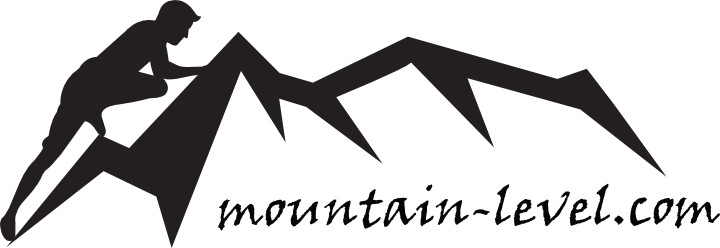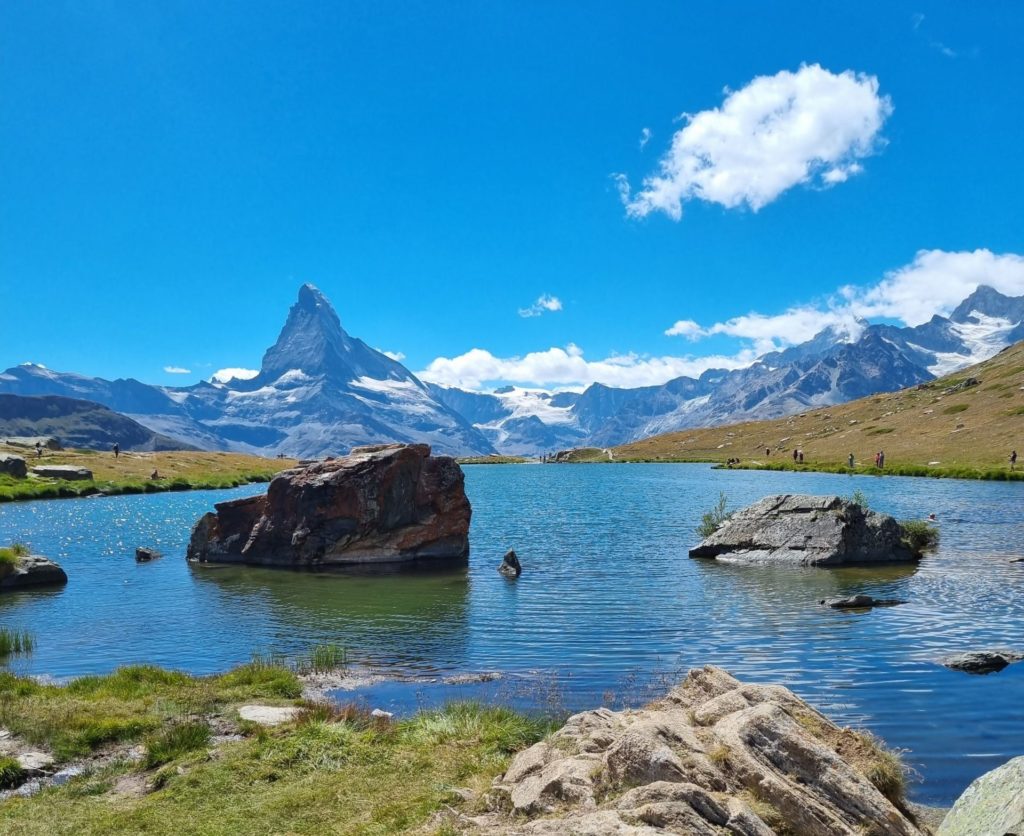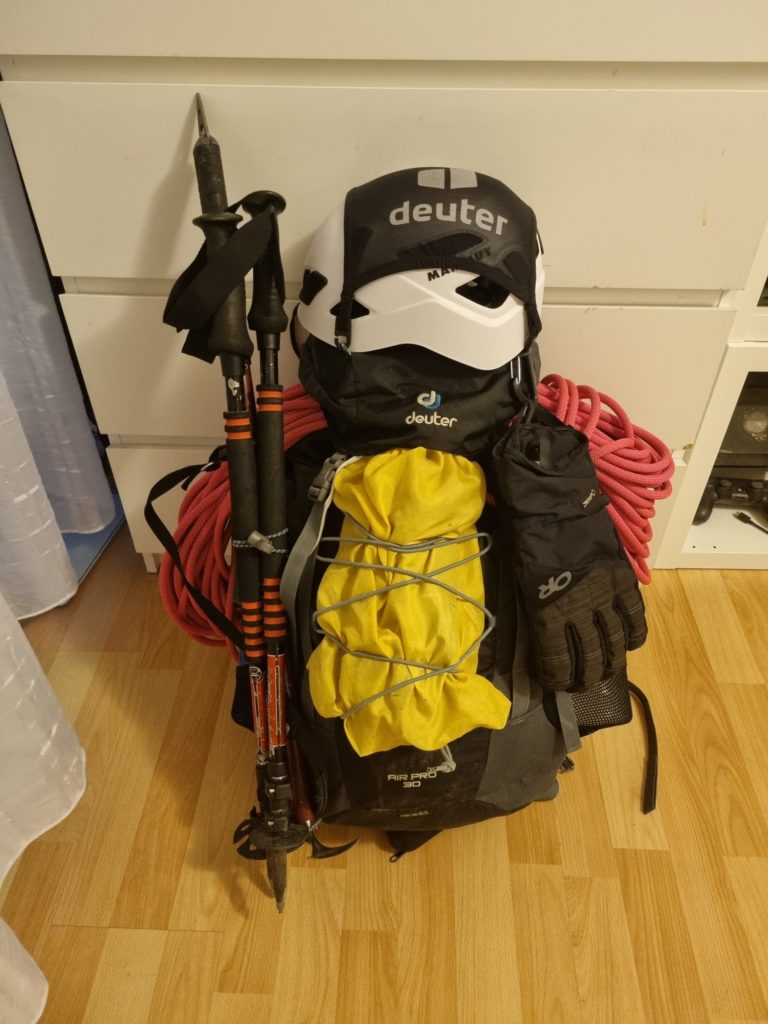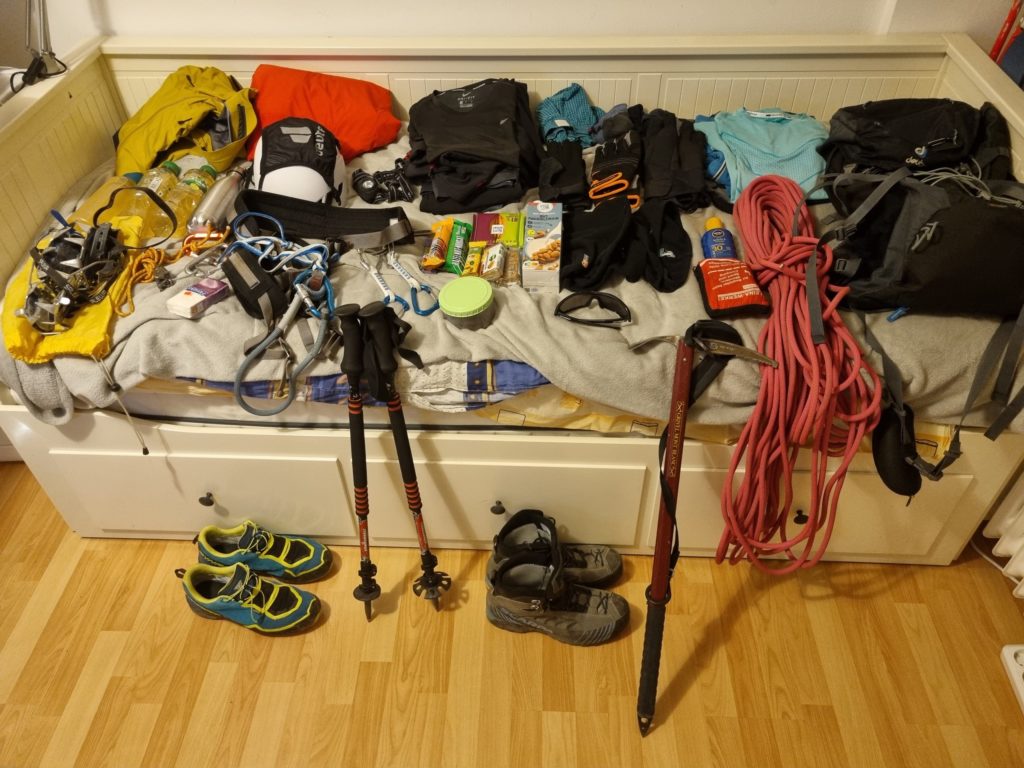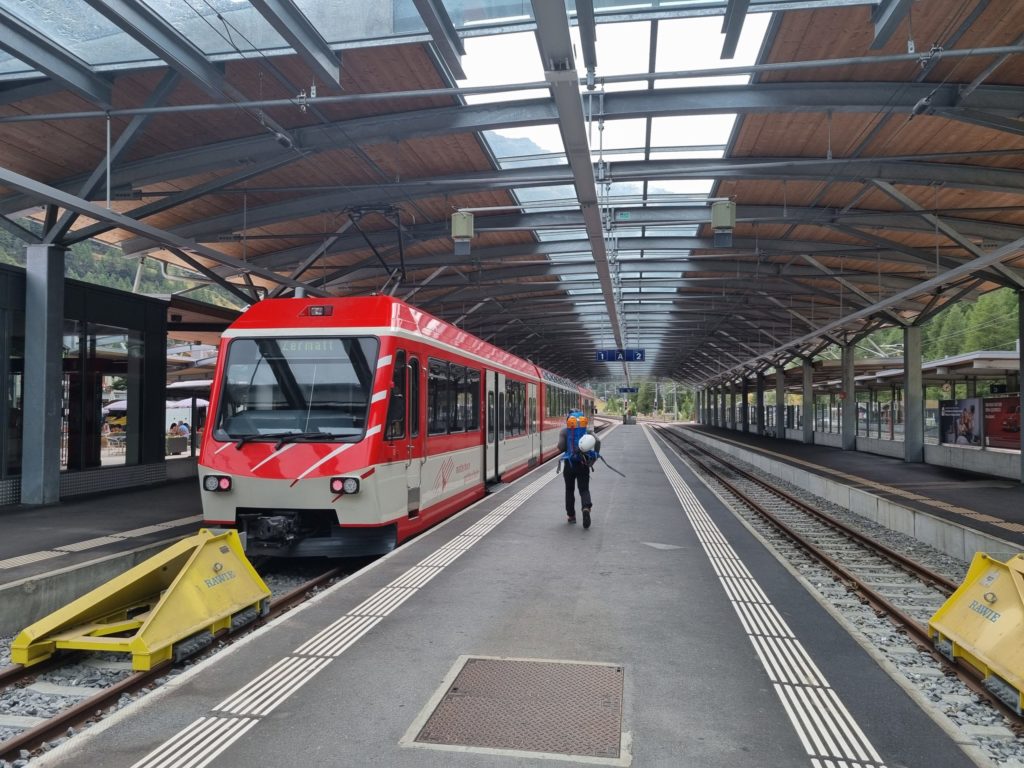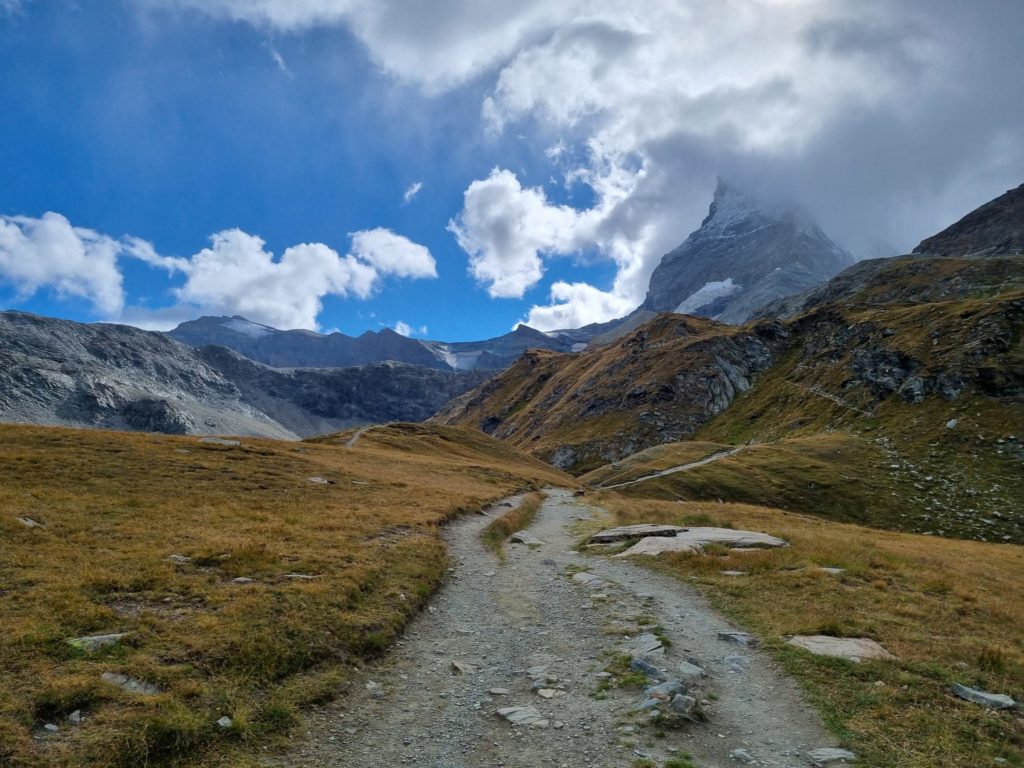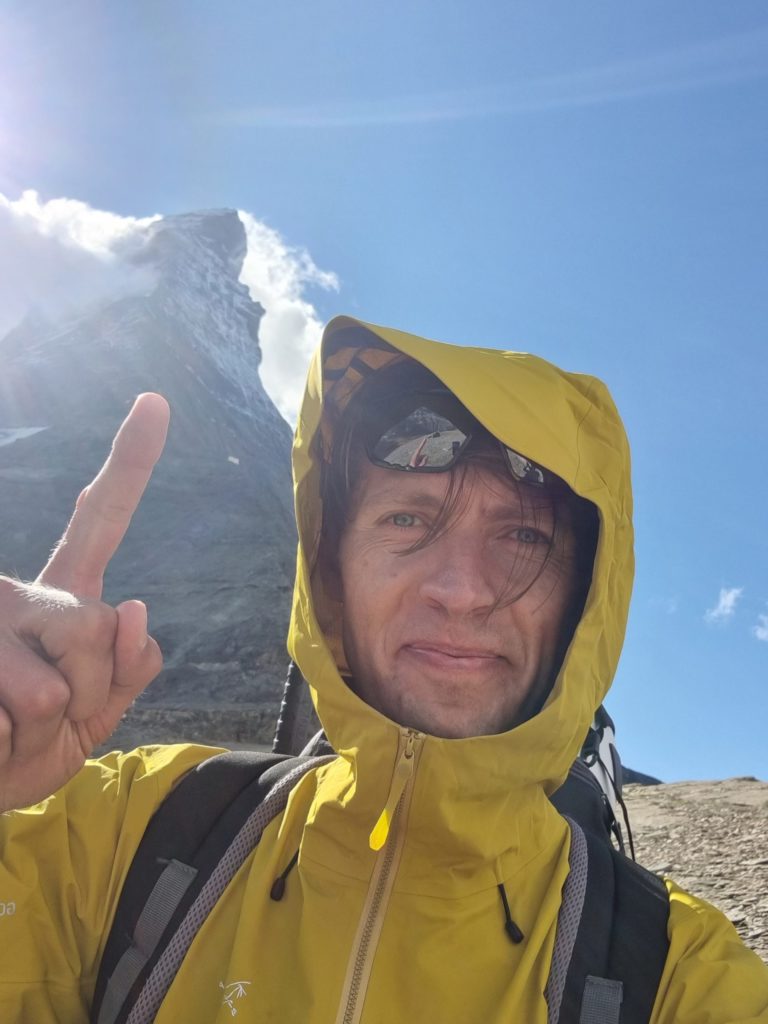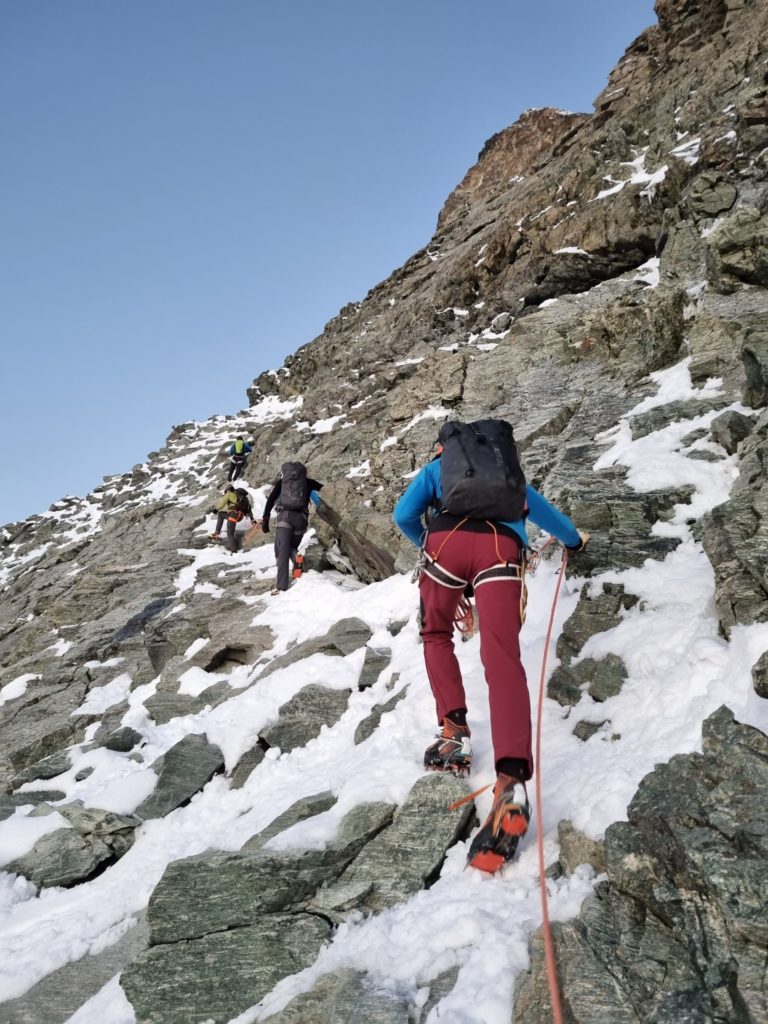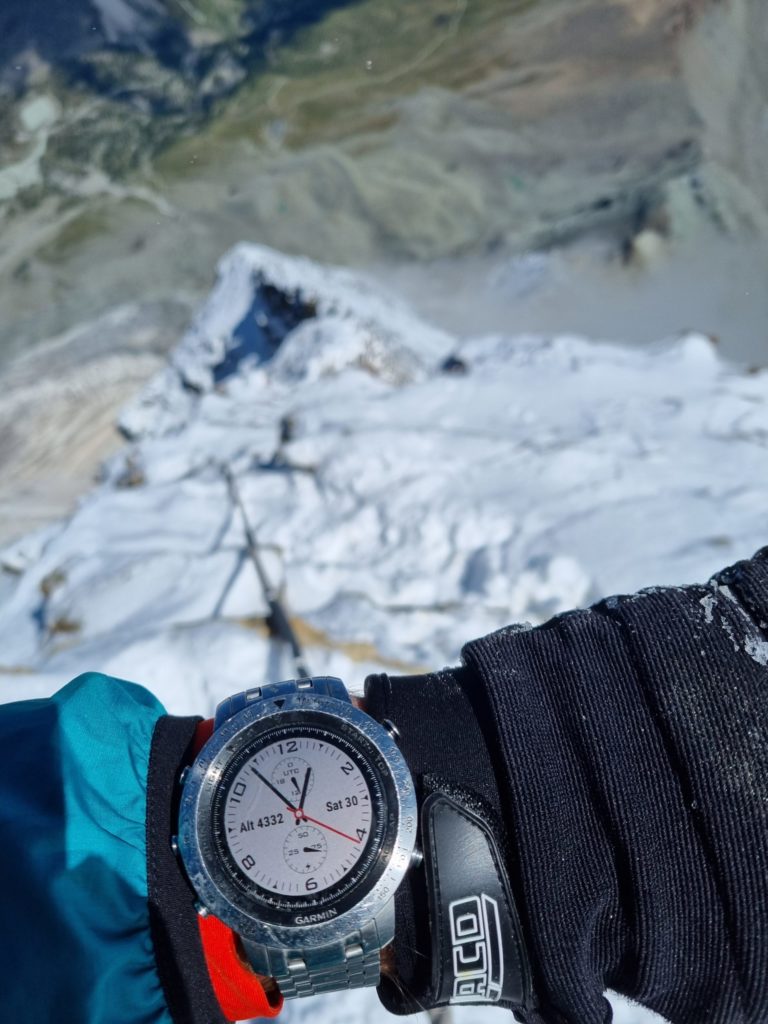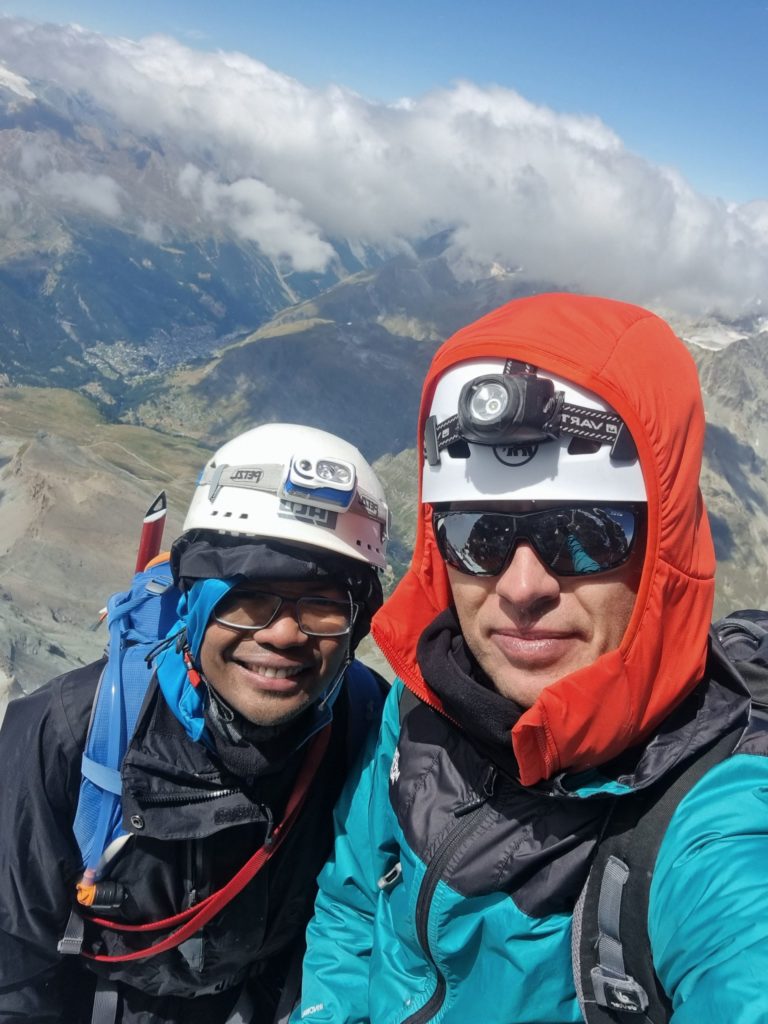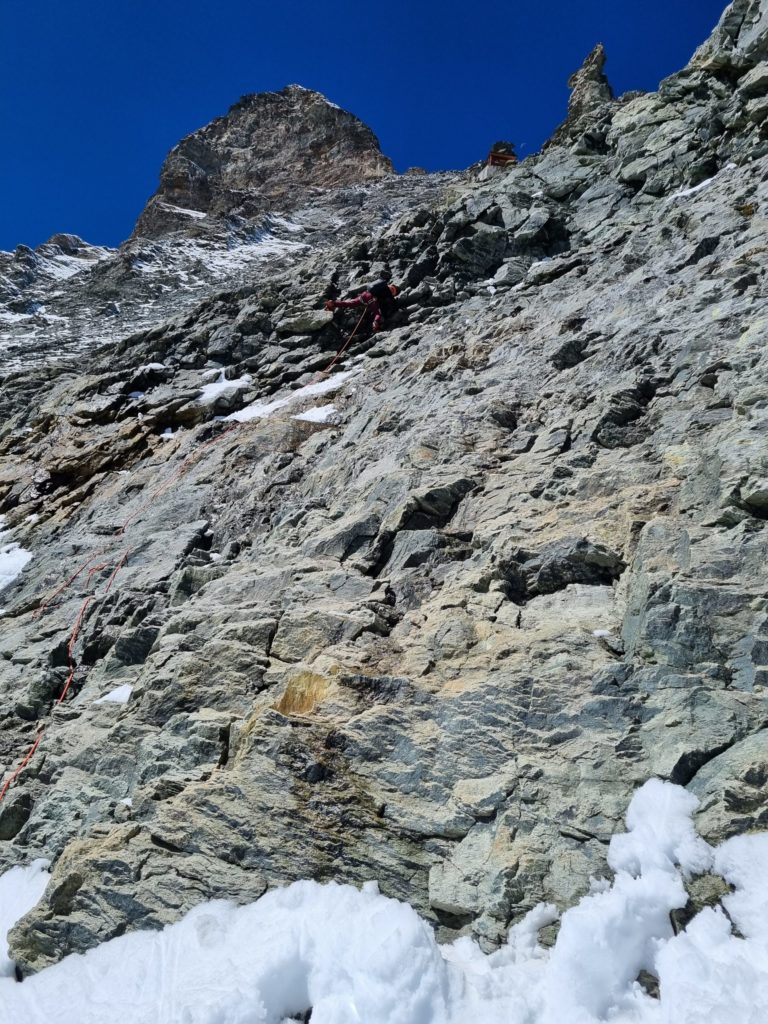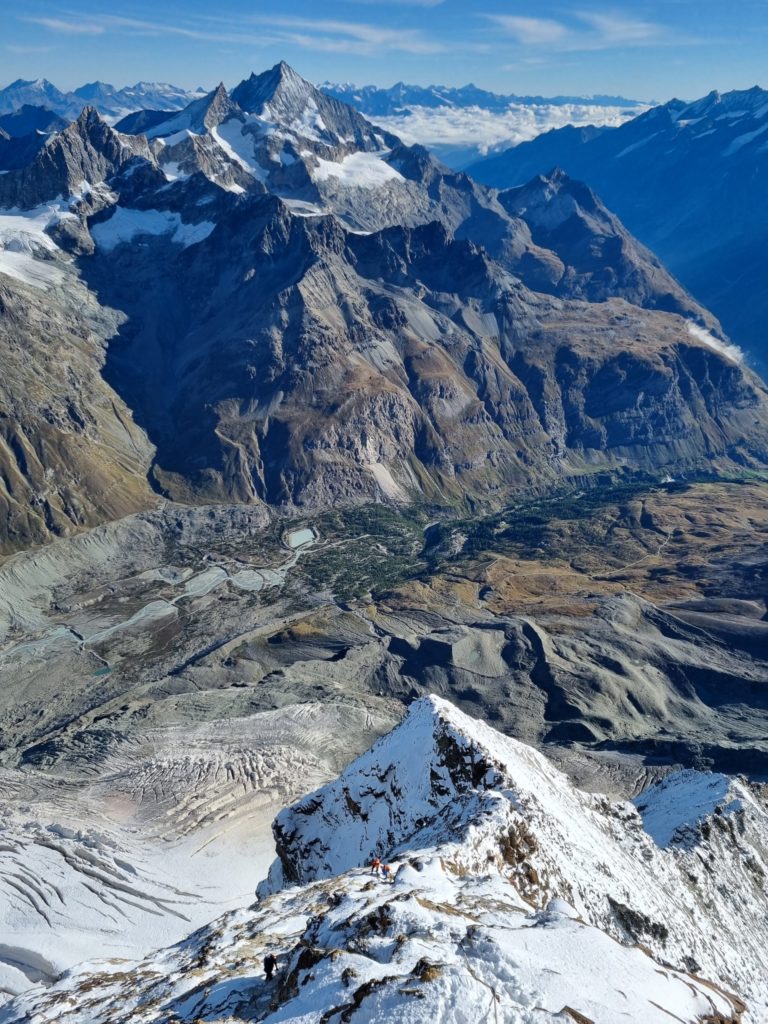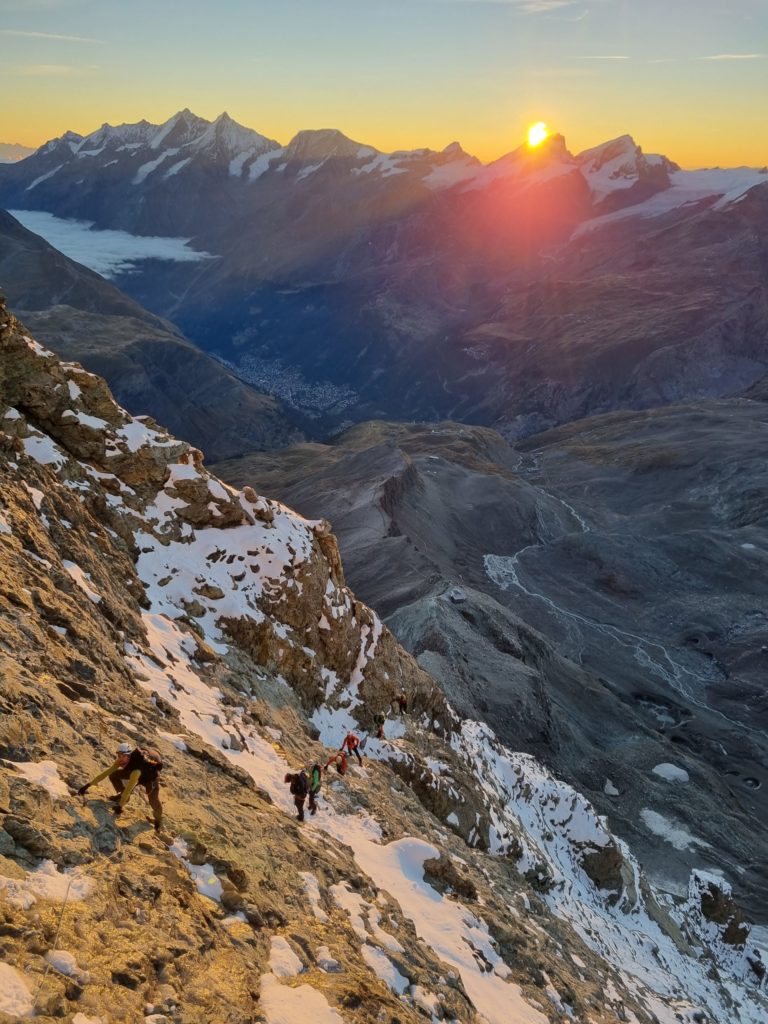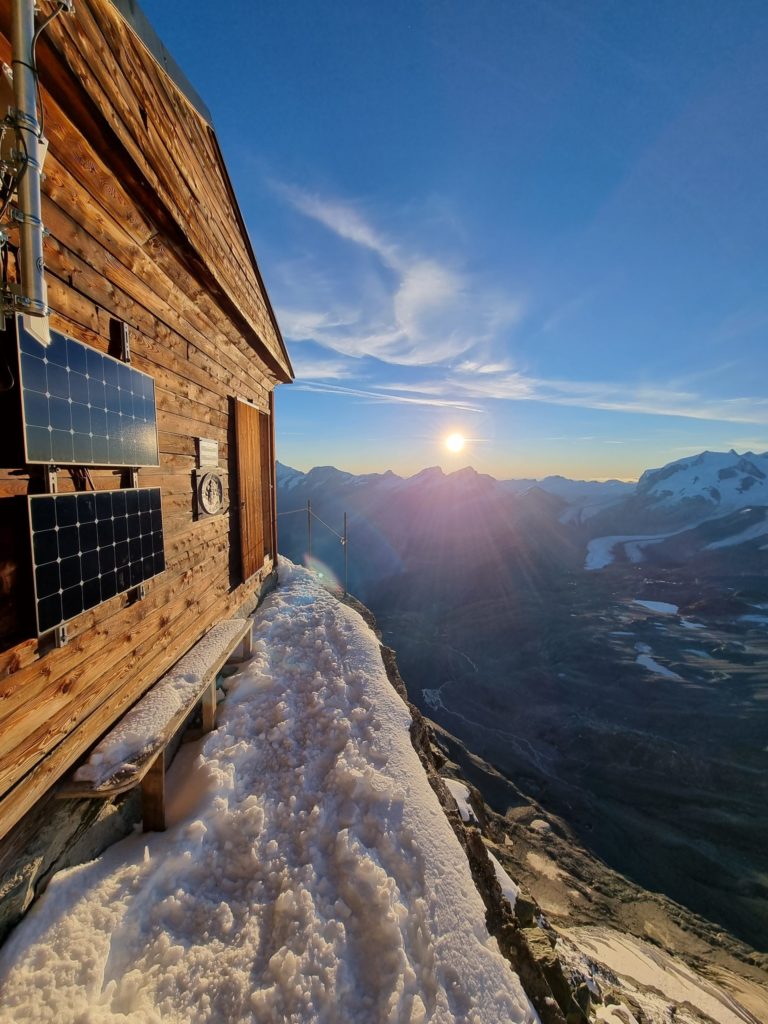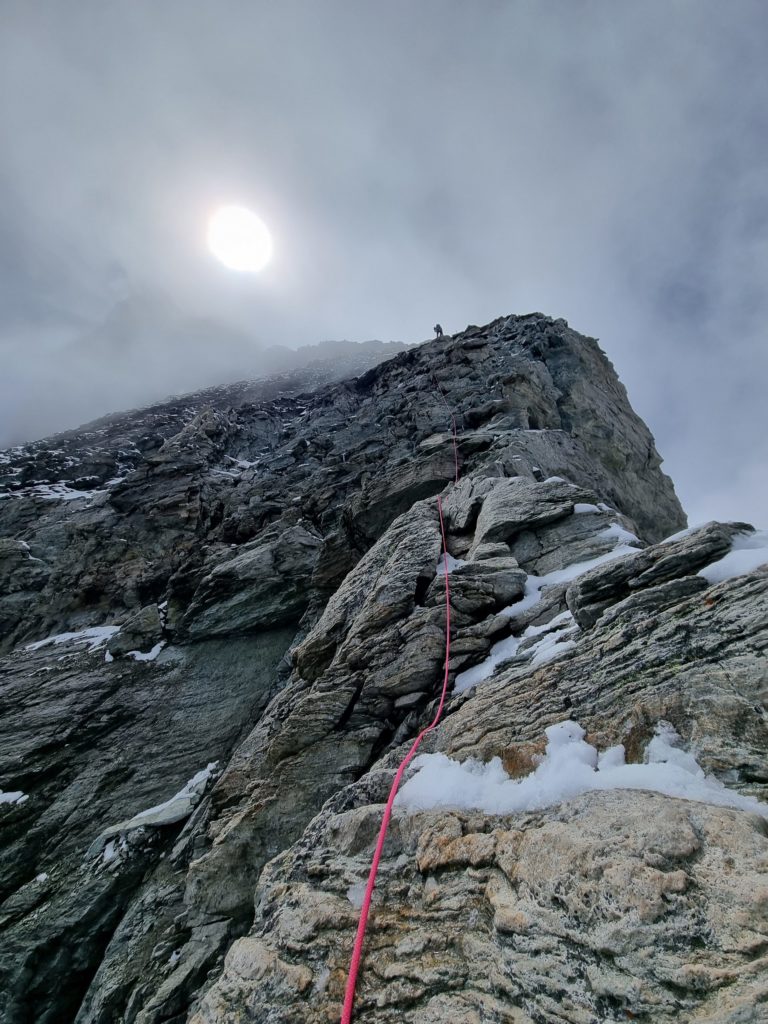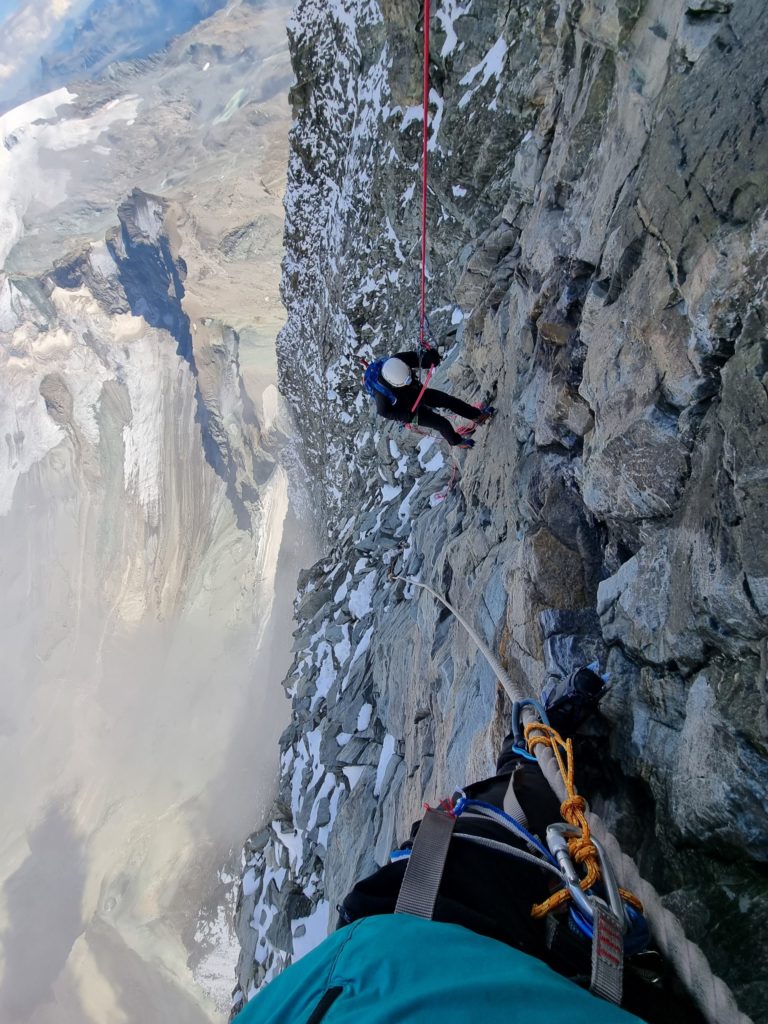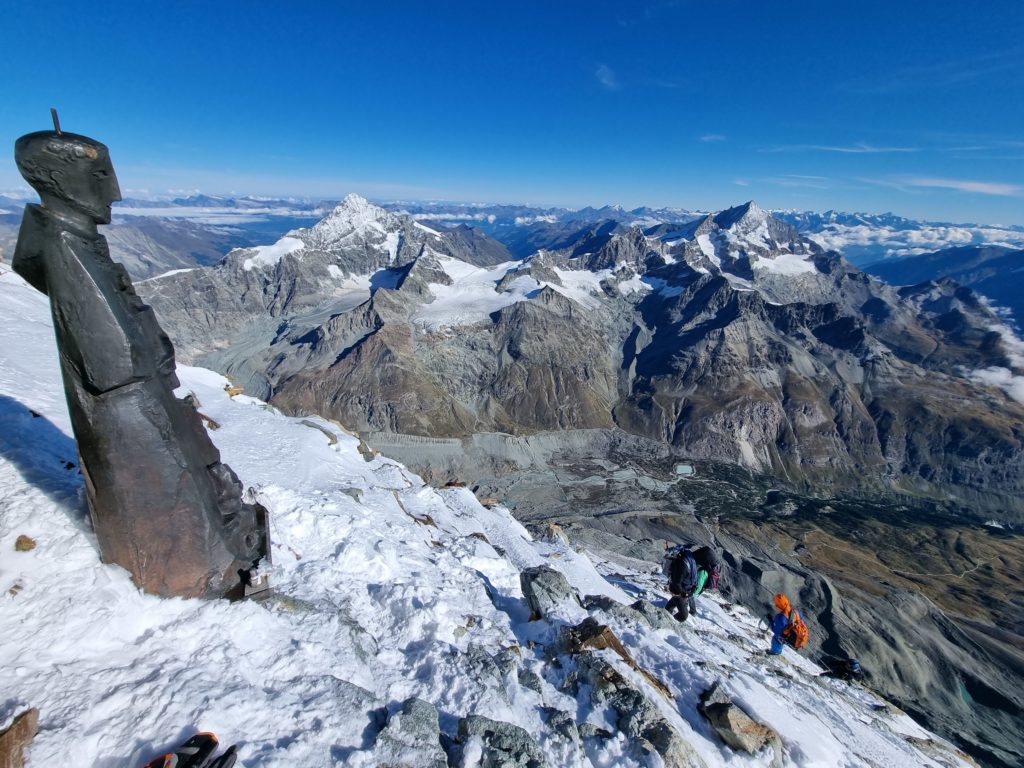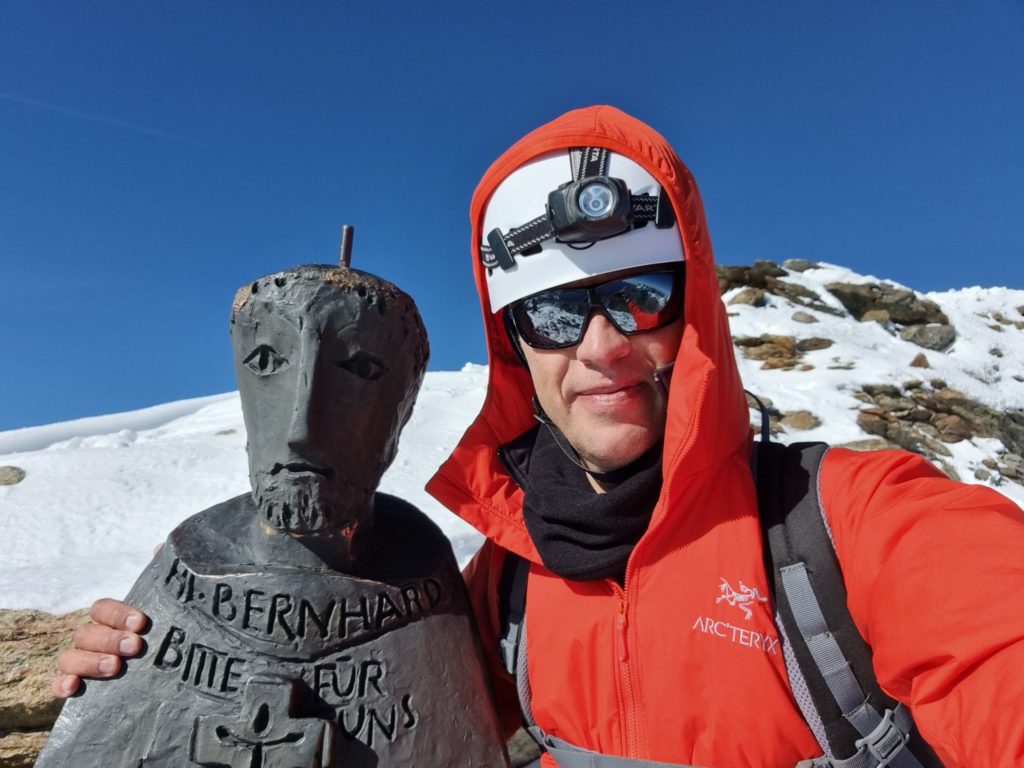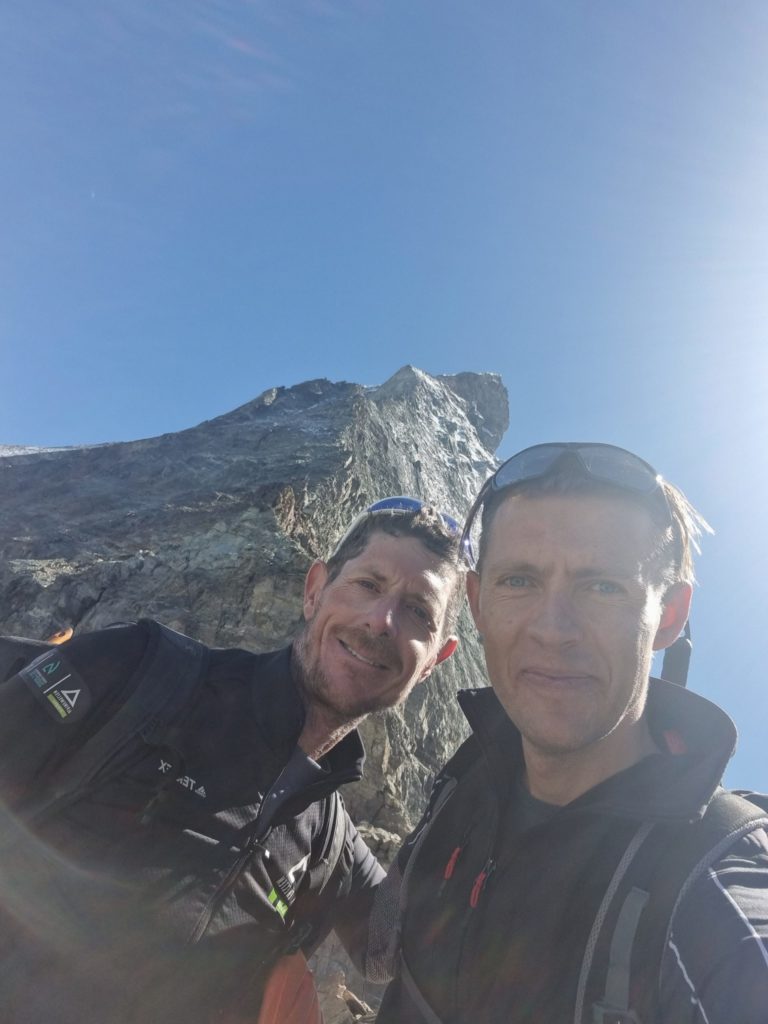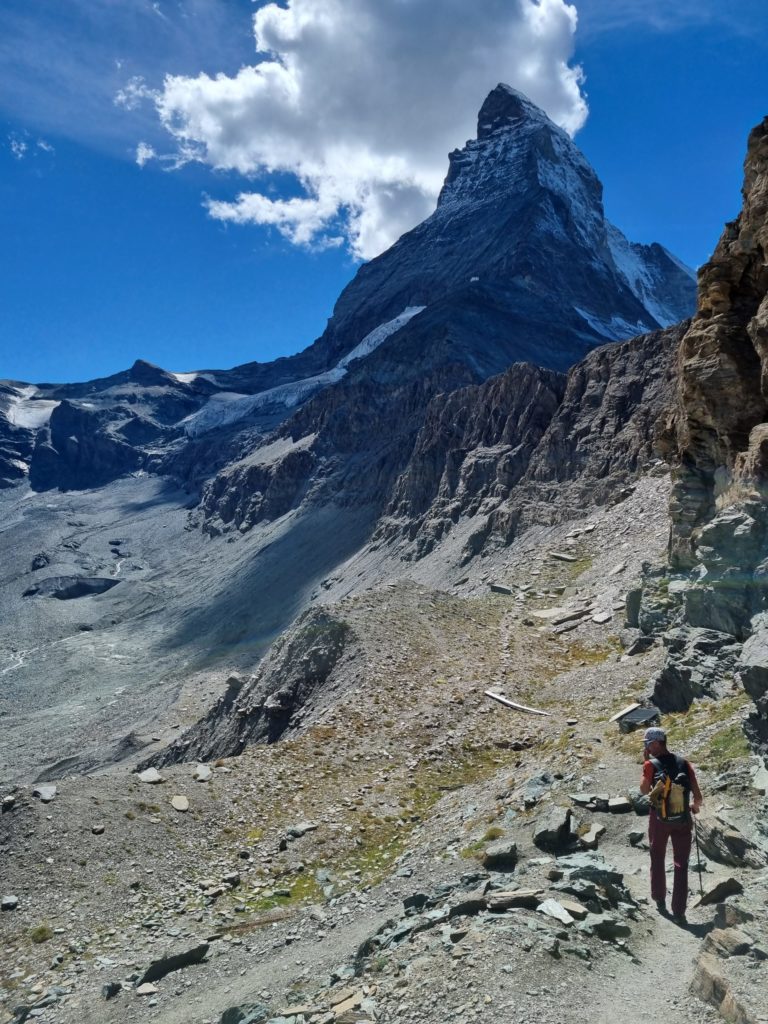For a long time, I had this mountain in front of my eyes. Toblerone chocolate helped me to some extent, but since I started hiking, a climb on the Matterhorn has become similar to an initiatory journey, like a search for the Holy Grail.
In case you didn’t know, the Matterhorn is one of Switzerland’s most famous landmarks and is located near Zermatt, on the border between Italy and Switzerland. It’s shaped like a steep, sloping pyramid, whose east wall is almost vertical and rises nearly 1000 meters above the glaciers.
Interestingly, this massif was once part of the African continent millions of years ago. Today, after several continental moves, it is one of the world’s most famous mountains and is on the bucket list of almost every climber.
The Matterhorn peak was considered impossible to conquer for a long time, and in 1865, two teams of climbers arrived intending to conquer Europe’s most challenging mountain. The Italian climbers competed with seven English climbers led by Edward Whymper.
After several failed attempts, Whymper chose a route that made the locals look at him like a madman: the eastern route, starting from Lake Schwarzsee, was considered “the most impossible of all impossible routes.” However, the Englishman’s decision was logical: since he had failed on the other routes, he thought it only natural to try to approach the mountain from the east.
On 14 July 1865, he became the first man to summit the Matterhorn, a mountain no one had ever conquered. But victory came at a price: on the way back, four of the seven members of the team fell down the cliff face.
I didn’t know much about this six months before the climb, but once the decision was made, I started reading more and more. I noticed that the thrill grew with each piece of information I learned and confirmed to myself that I had made the right choice.
I made a strategy and set an ascent date. Three months or 12 weeks beforehand, I started intensive physical and mental training and preparation for acclimatization.
I decided to do at least ten hikes of T5 or T6 difficulty with a minimum of 2000 meters difference before the trip to be physically prepared, get used to the alpine area, and reduce the fear of heights.
Zugspitze, Jubiläumsgrat, Großglockner via Stüdlgrat, Watzmannüberschreitung, Watzmannfrau, and Zückerhüttl were just some of them, and I always think what great hikes and memories I was able to gather during that time.
Time went by day by day, and each week, I noticed how my physical condition was increasing, and I felt more and more comfortable with climbing.
The plan went well, and finally, the day of departure arrived. As usual, Maston, my friend, arrived punctually at the meeting place, and on a Friday morning, we left Munich. After about 6 hours, we arrived at Täsch, where we were supposed to leave the car. We parked and continued our journey by train, arriving in Zermatt at 2 P.M.
From Zermatt, there were two possibilities to get to Hörnlihütte. The first is to take a cable car to Schwarzsee 2563 m and, from there, do the last hour on foot. The second is to start directly from Zermatt at 1600m and walk all the way up to the hut at 3260 m.
In our case, we left the cable car aside and set off on foot for proper acclimatization. Besides, we could enjoy the mountain as we had plenty of time till dinner at 7 P.M.
After a sunny week in Zermatt, it started raining, and the clouds got lower and lower. We couldn’t see anything around us, but the cold motivated us to arrive at the hut in less than 4 hours. We came completely soaked, and after drying off and changing clothes, we ate and went to bed. The sleep was long-awaited, but by 12, it finally arrived.
At 3:30, we woke up, and after getting our backpacks ready for the big climb, we had some breakfast. Fruit and cereals, coffee, and hot tea. Simple. We were still afraid about the weather, but during the night, the snow had stopped.
We filled our two thermos bottles with tea and set off.
There were 11 of us that day: two guides with their clients, two groups of friends, and the two of us. There’s a rule: first, leave the local guides, then the international ones, then the regular climbers.
We looked around and set off. After a few hundred meters, we reached the starting point. When we got to the vertical wall, the guides were far behind, and the three friends said they were waiting. We looked at each other and decided to go: that was why we came for.
I don’t know if going first was the best choice as we got lost many many times. Unfortunately, the tracks left by the others’ crampons were not visible, and as it had just snowed, we had to make the route. After half an hour, the snow turned to ice, and we put on our own crampons.
The climb became slower, and a huge surprise came over us both. There was nothing marked. No sign. No symbols. Absolutely nothing.
I’d read about it before, but till Hörnlihütte, everything was impeccably marked, like a highway. Why didn’t they continue?
Later I saw how around the mountain, one or two helicopters were constantly flying over. It was an element that surprised us both. How can you have helicopters constantly flying overhead but not mark the road?
Before the Solvay hut, we came to a more difficult section and decided to tie and strap each other. Frustration and fatigue set in, and we started to wonder: how do others make it to the top in 4-5 hours when it took us 6 hours only to the refuge?
The Solvay hut, at 4003m, was built in 1915 and is a place of refuge for climbers in difficulty. We also took advantage of the comfort of the two benches, took a short lunch break, and warmed up with some tea.
The snow cover was steadily increasing, and eight hours after leaving the Hörnlihütte, we finished the shoulder section.
Here I felt the consequence of one of my biggest mistakes so far. After a week of sunshine on the Matterhorn, I hadn’t anticipated that the few clouds predicted for Friday would turn to rain and snow, so I left the thick gloves in the car.
The cold was so intense, and the moment I put my hand on a carabiner clip, my fingers would stick to the cold metal. As if it wasn’t enough, if I stood still longer than 10 seconds and did not move my hands, I could see a layer of ice forming outside the glove.
That’s how the first doubts about the success of the ascent appeared, and what followed was one of the hardest decisions of my life.
What happens if I keep going and my hands don’t hold? What if the wind blows us off the mountain? I remembered some stories without a happy ending from Mont Blanc because it’s so easy to slide down and get swallowed by the abyss.
The strong wind amplified after the shoulder section, and I started to think pragmatically, as we had been in the red zone for a long time. What if we didn’t make the descent? What if the wind threw us off the cliff? We were already reviewing how long it had taken us to get up here, and we knew we had to turn back too.
Would we make it down in one piece?
A few hundred meters back, we met a guide and a client who told us the wind was too strong, and they were turning around. For them, it was not possible. Should we turn back too?
By hearing the whistling wind, we finally understood who was running the show. We continued to the vertical wall and noticed ice everywhere, with almost no place for the crampons.
If my hands don’t hold me, what do I do then? What if I fall? What if my hands freeze? What if I get frostbite? What if they cut off my fingers or my hands? What if the wind blows us off the cliff?
I looked at Maston and said we need to talk. Already my voice was different. We put together the information and decided we were going back.
30 seconds. That’s all it took.
In fact, we’d been summarizing what we’d been experiencing for the last hours.
It was one of the hardest decisions of my life. It was hard, but we knew it was the right thing to do. In the long run, it was the only solution.
With eyes almost tearing up, at 4332 m, almost 100 meters before the peak, we decided. We’re going back.
We set off to the cabin, knowing we had to focus on each step. From up there, at over 4,000 meters, you have a frightening view. There were times when I looked down and started to get scared. In those cases, I shifted my focus and started breathing differently, calmly, not to let the fear take over me. Days of working with my mind and my emotions proved helpful.
After a while, we arrived at the Solvay hut. It seemed as if the mountain didn’t want to let us go so quickly because the rope had jammed on the way down and didn’t want to follow us. For the cord to come loose, I climbed 20 meters back to untie it and released it from the trap. It wasn’t long before the rope got stuck again. This time Maston had to climb 30-40 meters up to untie it.
It was already getting dark, and the path was looking more difficult. We’d had trouble in the light with finding the route, but now in the dark, the previous beautiful landscape had turned into a frightening black sea, trying to take you over.
Fifteen hours had passed. Hunger, thirst, and exhaustion made room to fear. When would we reach the lower hut, the Hörnlihütte?
On the way, we met two other hikers who had lost their way, and Maston decided to go as a party of four, to go down to the hut together. For the last few hours, all we could think about was a bed and something warm, a rest.
We arrived at the hut at 12:30, having started at 04:30 after 20 hours on the mountain. What a feeling of relief. Yet the surprises kept coming. No one was awake; no one was at the reception. Unbelievable. We entered the cabin. No wind, no darkness, no cold. Just something soft. I made myself comfortable on an armchair and went to sleep. Maston opened the emergency bag and lay on the floor in the hallway, covered by the golden blanket.
In a few hours, the buzz in the cabin started as it was 4, and other tourists were preparing to climb. We swapped places with them and finally ended up in a regular bed.
We woke up slowly at 7, looked around, and, without a word, began to pack. After breakfast and steaming coffee, our mood changed a bit. The sun we had been waiting for the day before appeared out of nowhere and began to shine. .
We discovered that on the previous day, no one had reached the summit due to the strong wind. That’s how changeable the weather is there. On the one hand, we were happy, thankful that we made it back in one piece; on the other hand, we were sad that we didn’t make it to the top, the last hundred meters.
It was a fantastic, sunny day. We looked back one more time at this beautiful mountain, exhausted, happy, and sad at the same time, and set off for Zermatt.
Shit. If only we’d waited another day. The thing is, we only allocated three days. One for the road from Munich and the climb up to the hut. One for the ascent. One for the way back.
Even if we wanted to make one more attempt, we would still need at least one day for regeneration after the first try. We decided, for now, to let it all go.
After a few hours, we arrived in Zermatt and set off for Stellisee. Arriving at the lake, we realized there was a third member of our expedition: exhaustion. We only understood each other by eyes, and after an hour or so in the sun, we descended to Zermatt.
Our third entrance in two days into the famous little town, and I felt no joy. We ate something, and at 5 P.M., we set off on the train to Täsch. We packed our luggage and left for Munich at 6 o’clock.
At home, I realized my bed’s comfort: soft, clean, and pleasant smell.
The next day at lunch, I was surprised at how flat everything was. In the evening, when I went out, the same thing happened. Everything was flat.
On that day, something wouldn’t let me in peace. Even though I had reached 4332m, 100 meters to the summit, I felt no joy. I had been preparing myself for three months and wanted something else.
I was beginning to ask myself: how do I perceive this whole experience? Why was I doing this? Why did I go on this mountain?
Some say the journey is more important than the goal. Was that also true in my case? Can I accept that I didn’t make it to the top? Can I accept the result? Can I accept myself?
The situation would have been different if I had the warmer winter gloves. Also, if we had had some other group to go ahead, we would have saved a lot of energy. About the wind? … Who knows … maybe.
Can I accept that I was wrong? Can I admit I was shallow and made a wrong decision by leaving my gloves in the car? Yes.
Can I accept that I’m human and mess up occasionally? Yes.
Did I get anything constructive from the whole experience?
I like myself the way I am, even if I “fuck up” occasionally.
Isn’t that what’s most important? Self-acceptance?
The first day after the hike, I was sad, tired, and down. Nothing seemed to work. The rage wanted to get a hold of me, so I started applying everything I knew from NLP to avoid letting it get to me.
I was angry, but I was aware of my anger. I knew it would pass.
The next day I was still tired. The anger was starting to go away.
On the third day, I slept more than usual and felt better. I felt more rested, and the sadness turned into a neutral state. I focused on other projects and started planning for a new trip. I resumed sports, push-ups, and sit-ups, and an idea appeared.
After much reading and informing, I wondered how others did it in less than 10 hours when we needed 20. It’s not just fitness that matters? Where did we go wrong?
Day after day, the famous pyramid of Switzerland was still on my mind, so I started looking for alternatives. But who to go with? Maston is going to Spain. For this hike, I trusted only him. Who else?
Time passed, but eventually, a new option arose: what about going with a guide? What would it be like to go with someone who does this tour frequently? I’ll look for a guide and go for sure. This time, I’ll get to the top and give the story a different ending.
After significant research, I found a professional mountain guide I could do the climb with. Stephan Gödel. I looked him up and liked what I saw—an experienced guide, satisfied clients, exactly what I wanted. From the first moment, I understood he was experienced because the green light for the ascent didn’t come immediately as I expected. I was informed that I would receive the confirmation a few days before due to weather conditions and that I would be contacted.
Time passed, and I made my mind busy as much as possible and finally received the email. Okay: the predicted weather was good, and we could climb.
I started again: just like last time, I began packing. The feeling of déjà vu was everywhere, and with each item I put in my backpack, the excitement, and joy grew more and more. Because the last time I left the gloves in the car, this round, I made sure to buy another pair of long climbing gloves. From that point of view, I was ready.
Riing! Riing! Riiiiiiing!
Like a fire alarm, the clock made sure I would wake up, and at 05:15; I jumped out of bed. I was already familiar with the preparation, and at 6 A.M., the car was already moving through the empty streets of Munich.
Only after 10 minutes of driving, it hit me. I had forgotten something!
Shit! I had forgotten the Ibuprofen!
I didn’t have any problems last time with acclimatization, but I didn’t want to risk it. I returned for the tablets as I didn’t want to repeat the glove story. I took the pills and set off again, happy with my decision.
After almost 6 hours of driving, I arrived at Herbriggen near Zermatt, where I finally met Stephan. We chatted briefly, reviewed the equipment, and took the train to Zermatt. I got my ticket from the train, and for 20 francs, we also covered the last 30 minutes to the official starting point.
Do you know what an avalanche is? When entering Zermatt, a massive wave of memories and emotions passed over me, and excitement hit me. It was exactly what I needed. We left Zermatt at 15:15, as the body gets used to the higher ground much better when climbing gradually.
The sun was shining in the sky, and we started on foot to the Hörnlihütte to get as acclimatized as possible. The wind increased, and by 2500m, the windbreaker didn’t manage, so I swapped it for the Arcteryx hard shell. I was delighted with the decision as the difference was noticeable. Inside, it was hot, even if it was pretty cold on the outside.
Compared to last time, I feel weaker, but after 2-3 weeks of rest, it’s normal. Anyway, my fitness level was still good. On the way to the hut, I climbed with over 500 with a 13 kg backpack. I was hardly sweating, and my breathing was steady and constant, like in a song where you always have the same rhythm.
After almost 3-4 hours, we arrived at the Hörnlihütte and in the dining room where last time there were 20 people, now there were more than 60-70. Stephan greeted me, and we started to unpack.
I found a seat by the window in the pyramid’s company, and at 7, we ate. After some mountain stories shared by Stephan, he started to brief me for tomorrow.: “There are 11 guides and 48 extra.” and told me that we would start among the first.
I kept looking at the mountain. It’s so amazing to stand so close to it in complete safety. I remember so many Youtube videos, and I was actually there. 2 times in 3 weeks.
I got into bed around 9-10, and just like last time, I moved until 12, when I finally fell asleep. The waking up time was at 4:00, and I decided to enjoy the warmth of the bed for another 10 minutes. Finally, I got up and packed my bag despite feeling very tired.
Even though everyone was awake in the room, no one was talking. Everyone was solemn and focused, like the day of the most important exam. I prepared my backpack and returned my summer stuff to the luggage room. Three liters of tea, water, chocolate, and a few bars would be my meal on the journey ahead.
I met Stephan in the dining room, ate some cereal bars, and had a short coffee. It was 4:40. I also brought my backpack close to the door, next to Stephan’s. He was the third guide, meaning we were #5 and #6 coming out the door.
I walked down the hall, put on my helmet, gloves, lamp, and jacket, and looked back. Because we were almost the first ones near the exit, I didn’t know what was back there. I looked up, and I got cold feet once I saw what was behind us. The whole hallway was full of people. Over 50-60 Matterhorn enthusiasts, and still, it was a church-like silence where you could hear your heartbeat.
It begins. It’s 4:50, and the door opens. We set off, and at the first vertical wall, we started climbing.
I looked back and saw 60 little lights pointed at me. They were all waiting to climb. I took a deep breath and took off. The next time I would look back would be in one hour, at sunrise.
At that moment, I noticed the difference in climbing with a guide. If the first time, we were choosing the route with difficulty, often getting lost, with Stephan, we walked as if there were rails on the mountain. He knew exactly which path to choose.
We walked as if according to a carefully calculated plan, and in two hours, we were at the Solvay hut. Crazy! Crazy! Crazy! The first time it took us eight hours; now we are here in two. We grabbed a drink, ate some power bars, and set off again.
Whether it was the lack of sleep over the last few days, the drive from Munich, the altitude, or the climb up to Hornlihütte, the thing is that after the Solvay hut, I started to feel like it was getting much harder.
We set off again and started to see more and more snow. Up white, down white, left and right, nothing but a gap of kilometers.
We reached the place where Maston and I decided to turn back. I looked at the clock; the number 4332 made me relive it all. What a sensation! With all that cold, tears were welling up in my eyes. I told myself that this time it was happening. This time, I’m doing the extra step. This time, I’m continuing.
The statue of St Bernard. Black, cold, life-size. After two hours from the Solvay hut, I saw it. Step by step, I was thinking about the chance I had.
Just a little further, and I was up on the summit. I also learned that St. Bernard had been the patron saint of climbers and mountaineers since 1923. It’s also where the name of the St. Bernard dogs, who rescue tourists on the mountain, comes from.
We made it! The weather was good, and we reached the summit.
At 4478m, I had one of the most beautiful lunches of my life, on the top of the Matterhorn, right on the ridge between the St. Bernard Statue and the cross on the Italian side.
I can’t remember what I ate, but the view and the feeling definitely got seven stars. Something to always remember.
Like any climber, I took a few more photos after enjoying my meal and headed back. It took us two and a half hours to Solvay Hütte and two hours to get down. In total, with breaks, around 9 hours.
When I set foot on leveled terrain, I let go of everything I had held in for the last four months. A wave of emotions rushed over me, and I started crying, just like in Kilimanjaro or Mont Blanc.
What is it about these mountains?
After a few meters, I could see the tourists from the Hörnlihütte standing and looking in awe at each returning climber. We started with 60 others but met only 20 climbers on the way back. That means a maximum of 30 out of 60 made it to the summit. Not an easy climb at all.
We changed into our summer clothes, gathered the equipment, and marked the moment with a fantastic chocolate cake. It was a time of celebration: we had just come down from the Matterhorn.
The last hour on the mountain passed quickly, and from Schwarzsee, I said I would take the cable car down to Zermatt. The ticket wasn’t cheap, but for the 40 francs I paid, I admired from above the path that 24 hours ago I had climbed to Hörnlihütte. On the way back, we made our way with smiles, meeting tourists worldwide.
We took the train to Herbriggen, another 20 francs, and I left for Munich in the afternoon. By 12:30 at night, I was home, where I proudly drew an x2 at the Matterhorn goal from my whiteboard.
How much can you do in just two days?
Hmmm … From now on, “It’s not possible” has a whole new meaning.
What an incredible weekend!
Thank you, Matterhorn! I’m sure I’ll see you again!
- Cosmin Mihoreanu
